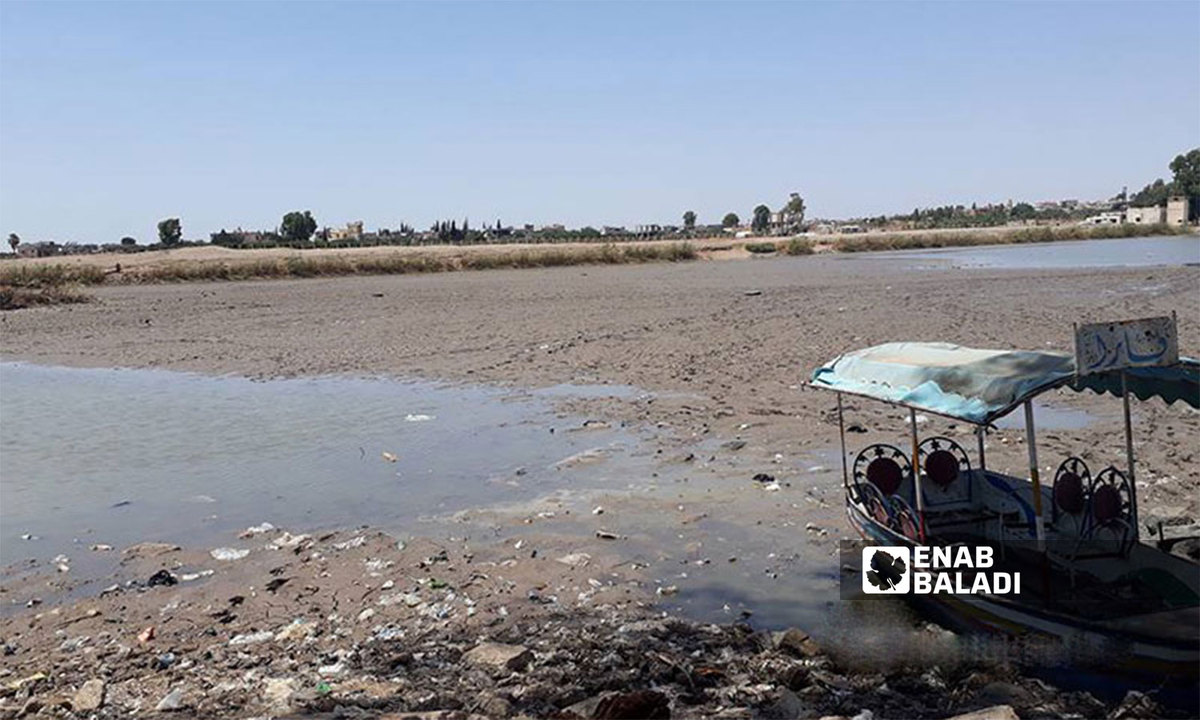



Enab Baladi- Daraa
Freshwater bodies and springs are numerous in most of the Syrian land, which need an earnest feasibility study to present its environmental importance along with biodiversity in the war-torn country also in regard to a proper tourism investment that comes with benefits for local residents.
Although water is the most influential resource in all Syrian regions, the dilemma of water has emerged over the past 11 years as one of the farthest challenges related to the human anguish of the people.
The tourist lake of Muzayrib, 11km to the west of southern Daraa city, has been witnessing a frequent decline in water level every year, which is a great loss for one of the most prominent tourist destinations in the town in southern Syria.
Unlike previous years, the lake’s water no longer flows this winter, which warns of the danger of its complete drying out. Therefore, the residents voiced fears that other springs and lakes in the town would continue to dry up, while the waterfalls of Tal Shihab and Zayzun lake in the western countryside of Daraa returned to flow only this winter.
The gradual decline in the water level of Muzayrib lake began about seven years ago, continuing in decrease until the lake’s water dried up in the summer of 2017, and turned into a seasonal lake that dries up in summer and returns in winter, but with a lower abundance than before.
The grounds are different, including the political, security, and service ones, in addition to the spread of random artesian wells, which are considered one of the main reasons for the drying up of surface springs and lakes in general in southern Syria.
According to a former employee of the Irrigation Directorate in Daraa, the large number of unplanned drilling of wells by the competent technical authorities led to drought after changing the ‘water veins’ paths from its subterranean watercourse.
The employee, 63, whose name was withheld by Enab Baladi for security reasons, added that the lake is shallow, and the drilling of wells has changed the course of the feeding lines, as the random drilling cuts off the subterranean watercourses as a result of the continuation of drilling in search of ‘water veins.’ This has a negative impact on the overall groundwater in Daraa, he added.
Before, drilling wells required a government license to determine the extent of their impact on the groundwater reserves, but now drilling is done without taking into account the damage that will be caused to the springs, said the irrigation expert.
Muzayrib lake is considered one of the largest surface water bodies in southern Syria, with a length of 2 kilometers and a width of 500 meters.
In addition to the tourist factor, the Muzayrib lake had played an important role in securing drinking water for the town of Daraa al-Balad and the center of the southern governorate, so that the Water Directorate implemented a project to draw water from the lake to As-Suwayda governorate in the 1990s when the water surplus played a role in watering agricultural crops in the towns of Muzayrib, and even Tal Shihab in the western countryside of Daraa.
Muneer al-Awda, Director of Water Resources in Daraa governorate, told the state-run Syrian Arab News Agency (SANA) in 2020 that the number of violating wells dug on the springs feeding the Muzayrib lake were more than 100 wells, while the number of violating wells that affected the springs reached 4000 wells, which caused the drying up of 13 springs, and affected the abundance of some of it.
Lake tourists have been revitalizing the commercial hub in the town of Muzayrib during the past years, where the shops and stalls all over the place sell soft drinks, ice cream, food, and hot meals. The shops were selling most of their products. In a beautiful scene, too, cars and tourist buses were stuffing in the town, the streets were teeming with life.
But now, everyone is affected. The fishermen lost an important source of livelihood since the fish wealth was destroyed after the lake dried up, and the shop owners lost their customers.
Lake Muzayrib is not the only tourist destination in the province of Daraa. There are dozens of tourist sites, but most of them are harshly hit by the seasonal drought, such as the waterfalls of Tal Shihab, west of Daraa, and the lakes of the Zayzun and al-Ajami that have dried up completely.
if you think the article contain wrong information or you have additional details Send Correction